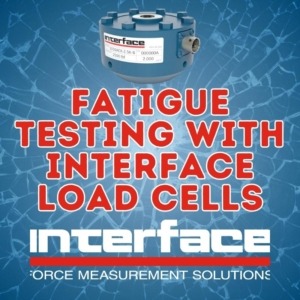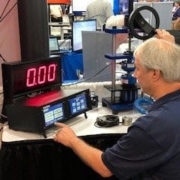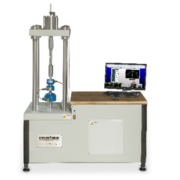Fatigue Testing with Interface Load Cells
 Engineers rely on fatigue testing to ensure the safety and reliability of their product designs and structures. By understanding how materials behave under repeated loading, engineers can design components resistant to fatigue failure.
Engineers rely on fatigue testing to ensure the safety and reliability of their product designs and structures. By understanding how materials behave under repeated loading, engineers can design components resistant to fatigue failure.
Fatigue testing requires accurate and reliable force measurement. Interface uses ‘fatigue-rated’ as an exact specification that defines a special class of load cell design and construction. Interface fatigue-rated load cells are designed to withstand the rigors of repeated loading, which makes them ideal for even the most demanding high cycle count fatigue testing applications.
In a typical fatigue testing setup, Interface fatigue-rated load cells are attached to the test specimen or the test machine, and the cyclic loading is applied according to the test protocol. The load cells continuously record the applied forces or stresses, allowing engineers and researchers to monitor how the material responds to repeated loading.
By analyzing the data from Interface load cells, researchers and material engineers can determine the material’s endurance limit, fatigue life, and stress-strain behavior. This information is invaluable for optimizing material selection, design, and manufacturing processes to enhance product performance and reliability while identifying fatigue and potential failure risks.
The use of fatigue-rated load cells and data logging instrumentation is necessary for most test and measurement applications, particularly when materials, parts, or assemblies are tested for destruction. This is true because an accurate record of the forces at every moment of the tests is the only way an engineer can analyze the stresses that occurred in the moments just before the ultimate failure. Read more about fatigue testing in our Interface’s Technical Library.
Interface Fatigue-Rated Load Cells
1000 Fatigue-Rated LowProfile® Load Cell
1000 High Capacity Fatigue-Rated LowProfile® Load Cell
1500 Low Capacity LowProfile® Load Cell
1208 Flange Standard Precision LowProfile® Load Cell
Profile of a Fatigue-Rated Load Cell
- Design stress levels in the flexures are about one-half as high as in a standard LowProfile load cell.
- Internal high-stress points, such as sharp corners and edges, are specially polished to avoid crack propagation.
- Extraneous load sensitivity is specified and adjusted to a lower level than in a standard LowProfile load cell.
- All Interface fatigue-rated load cells have a specified service life of 100 million fully reversed, full-capacity loading cycles.
No one can accurately predict exactly when the failure will occur, nor which part of an assembly will be the weakest link that eventually will fail. This is why high cycle count testing is the best way to measure fatigue life. To read more about fatigue testing and fatigue theory, consult Interface’s Load Cell Field Guide.
Fatigue Testing Applications
Interface fatigue-rated load cells are used in various industries, including aerospace, automotive, civil engineering, and manufacturing. They are used to test various products, from aircraft wings and landing gear to furniture and industrial machinery.
How Interface fatigue-rated load cells are used in fatigue testing:
- Aerospace: Interface fatigue-rated load cells test the durability of aircraft wings, landing gear, and other aerospace components. This helps to ensure that aircraft can withstand the rigors of repeated takeoffs, landings, and flights. These load cells test the materials used for structures and even rockets.
- Automotive: Interface fatigue-rated load cells test the fatigue life of engine components, chassis, and suspension systems. This helps to ensure that vehicles are safe and reliable and that they can withstand the stresses of everyday driving.
- Civil engineering: Interface fatigue-rated load cells test the fatigue resistance of bridges, buildings, and critical infrastructure. This helps to ensure that these structures can withstand the loads they are designed to carry and are safe for the public.
- Manufacturing: Interface fatigue-rated load cells test the fatigue life of industrial machinery, tools, and consumer products. This helps to ensure that these products are reliable and can withstand the demands of everyday use.
Watch how Interface load cells are used in this bike frame testing application.
Interface has specialized in fatigue-rated load cells and their applications since our founding in 1968. Our LowProfile® fatigue-rated load cells provide up to 100 million duty cycles, and the gaged sensors in every load cell are individually inspected, tested, and certified to meet our rigid performance standards.
It is imperative to choose the right load cell for your fatigue testing application. Load cells come in various sizes and capacities, so it is vital to choose one that is right for your fatigue testing application. Ensure you know the maximum load that will be applied to the load cell, the type of loading, the accuracy requirement, and the environmental conditions for testing. Consult with Interface application engineers to find the suitable load cell for your testing requirements.
ADDITIONAL APPLICATIONS AND RESOURCES
CPG Bike Handlebar Fatigue Testing
Interface Specializes in Fatigue-Rated Load Cells
Prosthetics Load and Fatigue Testing App Note
Furniture Fatigue Cycle Testing App Note
Aircraft Wing Fatigue App Note








